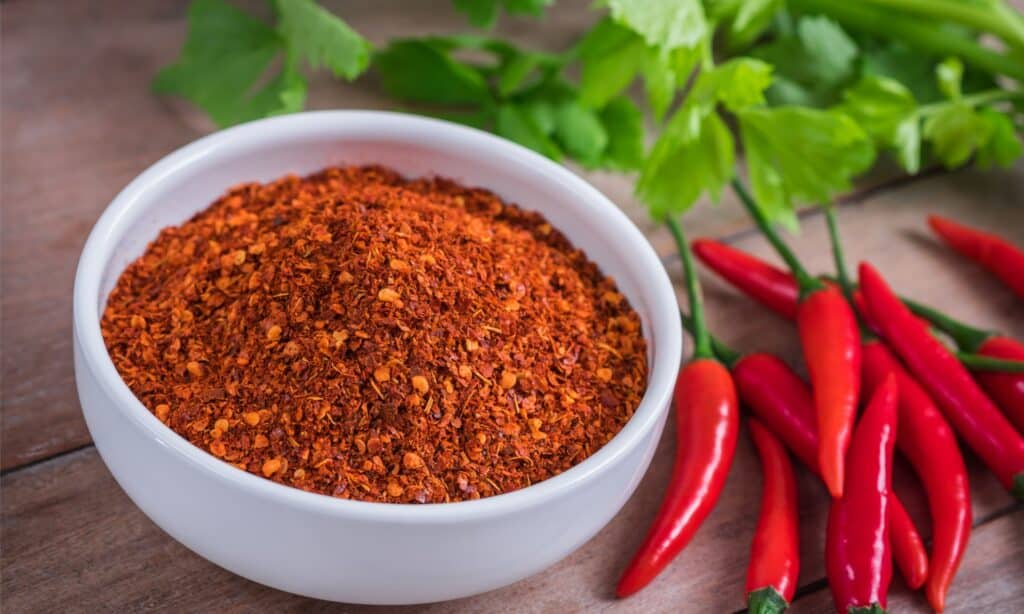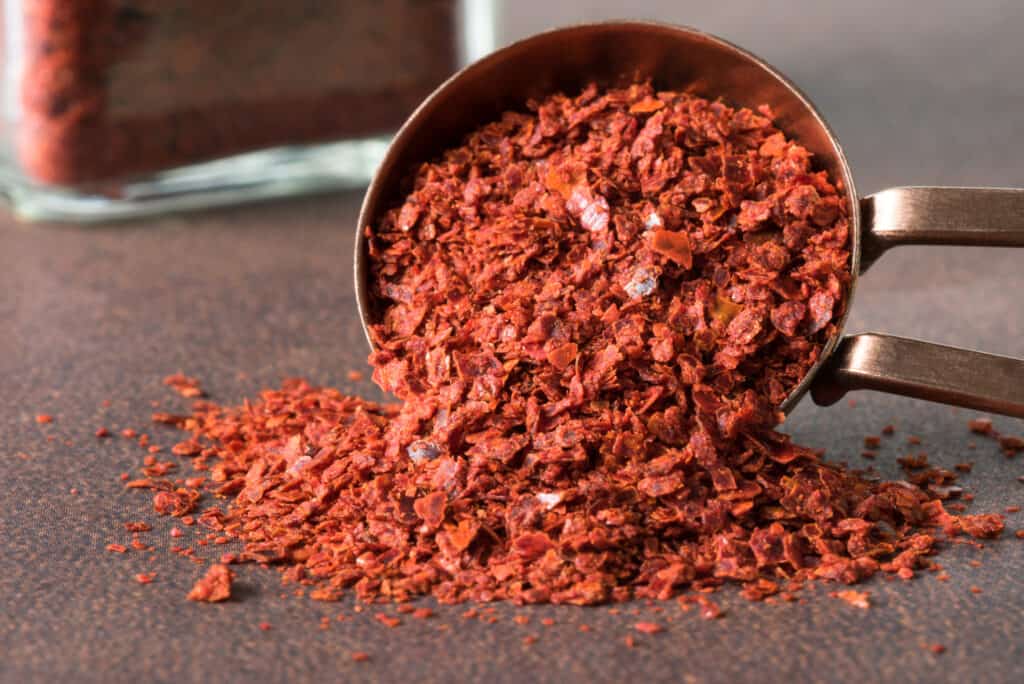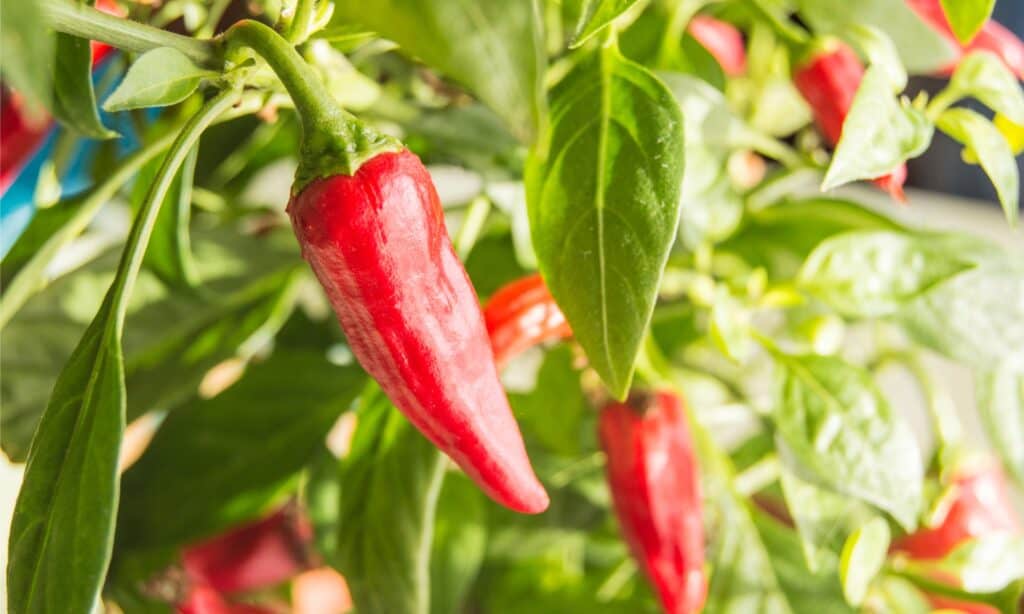It’s easy to accidentally mix up Aleppo peppers and cayenne peppers. Both hot peppers are a vibrant red and pack a spicy punch! However, cayenne peppers are more frequently used throughout the world as a spice and a great way to add color to dishes.
Whether you want to cook a new delicious dish or you are just curious, it is a good thing to know about the differences between Aleppo peppers vs. cayenne peppers.
Comparing Aleppo Pepper vs. Cayenne
| Aleppo Pepper | Cayenne | |
|---|---|---|
| Scientific Classification | Capsicum annuum | Capsicum annuum |
| Description | Oily, thick, but only grows between 2 to 3 inches long. These peppers are bright red or burgundy. Its tip is narrow, but the shape is similar to a jalapeno. Plants reach 2 feet tall. | With a taper shape and a curved tip, these shiny red peppers rarely grow longer than 6 inches. They are wrinkly, skinny, and referred to as ‘finger chillies.’ Plants reach 1-4 feet tall. |
| Uses | A middle eastern condiment often used in salads, beans, and as a meat seasoning. | Adds spice and heat to any recipe. Often used in soups, hummus spreads, and drinks like hot chocolate or lemonade. |
| Origin and Growing Preferences | It is a Syrian pepper often nicknamed the Turkish pepper. It grows in warm and sunny climates. | This pepper is originally from Cayenne, French Guiana; however, it grows throughout the world in full sun. |
| Flavor and Taste | The Aleppo pepper ranks 10,000 Scoville Heat Units and has a tangy and mildly sweet flavor. | Cayenne peppers rank between 30,000 – 50,000 Scoville Heat Units and have a hot and citrusy flavor. |
Key Differences Between Aleppo Pepper vs. Cayenne
There are a few key differences between Aleppo peppers and cayenne peppers. For example, Aleppo peppers are shorter and thicker, rarely growing longer than 2 inches. On the other hand, cayenne peppers are skinny and almost finger-like, regularly reaching 6 inches long. Cayenne is also a lot more popular. This pepper is frequently used in hot sauce and food recipes since it packs more of a punch and gives a distinct red color.
Ready to learn more about the differences between each? Keep on reading.
Aleppo Pepper vs. Cayenne: Classification

Aleppo peppers are part of the
Capsicum annuumspecies.
©iStock.com/MichelleLee3900
Although we are mostly talking about the differences between each fruit, they do have the same classification. Both Aleppo peppers and cayenne peppers are part of the Capsicum annuum species. Other notable peppers in this species are jalapenos, bell peppers, and pimentos. They also belong to the same nightshade family, Solanaceae.
Aleppo Pepper vs. Cayenne: Description

Cayenne peppers are known for being skinny and long.
©iStock.com/Amarita
At first glance, these peppers may look alike, but they are not identical. The average Aleppo pepper is short, stocky, and can easily be mistaken for its closely related cousin, the jalapeno pepper. It is a thick pepper, sometimes measuring up to 3 inches wide. The tip of the pepper is narrow, while the top is thick. Aleppo peppers are also a deep red, similar to cayenne peppers.
While cayenne peppers and Aleppo peppers may belong to the same family and mature to a deep red, that is where their similarities end. Cayenne peppers are notoriously known for being skinny and long. Despite their thin size, they are hotter. These peppers are also wrinkly, which is very different from the smooth texture of Aleppo peppers. Even with all of their differences, Aleppo and cayenne peppers grow from similar plants to small white flowers.
Aleppo Pepper vs. Cayenne: Uses

Aleppo peppers are often dried and ground to a fine powder that acts like a seasoning.
©iStock.com/Michelle Lee Photography
The possibilities are endless when discussing the many uses of Aleppo peppers and cayenne peppers. Firstly, Aleppo peppers are mainly used in Turkish, Middle Eastern, and Mediterranean cuisine. While you can roast and eat these peppers raw, they are often dried and ground to a fine powder that acts like a seasoning.
Cayenne peppers are more universal. They are often used as a substitute for the tabasco pepper. It is also dried and ground into a powder used in Central American cooking. Interestingly, regularly consuming cayenne peppers also comes with health benefits, including anti-inflammatory properties, weight loss, and a large amount of vitamin C and A.
Aleppo Pepper vs. Cayenne: Flavor and Taste

Cayenne peppers almost taste sweet and fruity, even when dried and roasted.
©iStock.com/ClaireLucia
Most people looking for information about Aleppo pepper vs. cayenne want to find a spicy pepper. You are in luck since both Aleppo and cayenne peppers are hot, but they have very different flavors. Cayenne peppers almost taste sweet and fruity, even when dried and roasted. It is a neutral hot pepper often used to give dishes a bright red color. On the other hand, Aleppo peppers are tangy, with hints of citrus. Many people cook with Aleppo pepper seasoning because it has a touch of earthiness, almost like cumin.
How to Grow Aleppo and Cayenne Peppers
Aleppo peppers and cayenne peppers are similar enough that you can use the same growing instructions. Imagine not having to spend extra money buying these two powerful peppers and instead picking them fresh from your garden! First, you need to purchase the right seeds. It is always best to go with seeds designed for your local growing climates.
It is also important to note that while Aleppo peppers and cayenne peppers are not native to most of the world, they are easy to grow anywhere the temperature reaches 90 to 100 degrees Fahrenheit. The seeds need warm soil to germinate. Once they germinate, water only when the soil begins to dry out. Too much watering can cause root rot, which will slowly kill your pepper plant and produce a strong smell. It takes between 5-9 months of careful growing to harvest your very own hot peppers.
Up Next:
- Habanero vs. Ghost Pepper: What’s the Difference?
- Cayenne Pepper vs. Red Pepper: Is There a Difference?
- Scorpion Pepper vs. Ghost Pepper: What’s the Difference?
- Ghost Pepper vs. Carolina Reaper: What’s the Difference?
The photo featured at the top of this post is ©
Sources
- Cleveland Clinic, Available here: https://health.clevelandclinic.org/cayenne-pepper-benefits/
Thank you for reading! Have some feedback for us? Contact the AZ Animals editorial team.






